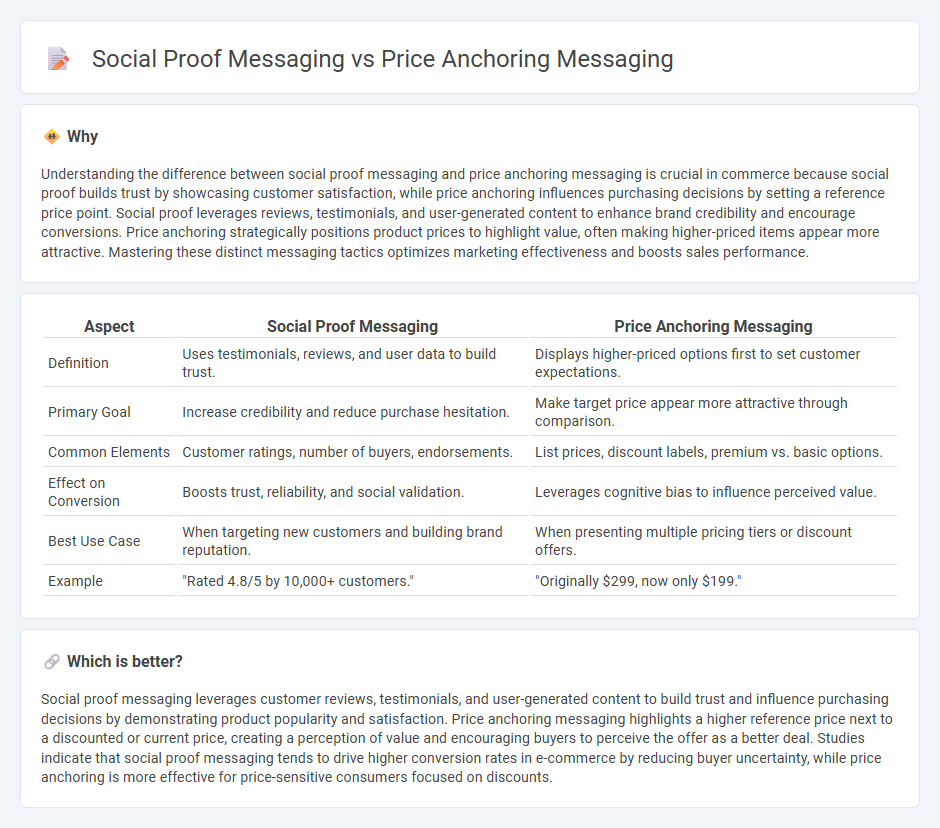
Social proof messaging leverages customer testimonials and reviews to build trust and credibility, enhancing perceived value in commerce. Price anchoring messaging highlights a comparison between original and discounted prices, influencing consumer perception of deal attractiveness. Explore detailed strategies to optimize your commerce messaging effectiveness.
Why it is important
Understanding the difference between social proof messaging and price anchoring messaging is crucial in commerce because social proof builds trust by showcasing customer satisfaction, while price anchoring influences purchasing decisions by setting a reference price point. Social proof leverages reviews, testimonials, and user-generated content to enhance brand credibility and encourage conversions. Price anchoring strategically positions product prices to highlight value, often making higher-priced items appear more attractive. Mastering these distinct messaging tactics optimizes marketing effectiveness and boosts sales performance.
Comparison Table
| Aspect | Social Proof Messaging | Price Anchoring Messaging |
|---|---|---|
| Definition | Uses testimonials, reviews, and user data to build trust. | Displays higher-priced options first to set customer expectations. |
| Primary Goal | Increase credibility and reduce purchase hesitation. | Make target price appear more attractive through comparison. |
| Common Elements | Customer ratings, number of buyers, endorsements. | List prices, discount labels, premium vs. basic options. |
| Effect on Conversion | Boosts trust, reliability, and social validation. | Leverages cognitive bias to influence perceived value. |
| Best Use Case | When targeting new customers and building brand reputation. | When presenting multiple pricing tiers or discount offers. |
| Example | "Rated 4.8/5 by 10,000+ customers." | "Originally $299, now only $199." |
Which is better?
Social proof messaging leverages customer reviews, testimonials, and user-generated content to build trust and influence purchasing decisions by demonstrating product popularity and satisfaction. Price anchoring messaging highlights a higher reference price next to a discounted or current price, creating a perception of value and encouraging buyers to perceive the offer as a better deal. Studies indicate that social proof messaging tends to drive higher conversion rates in e-commerce by reducing buyer uncertainty, while price anchoring is more effective for price-sensitive consumers focused on discounts.
Connection
Social proof messaging leverages customer reviews and testimonials to build trust and influence purchasing decisions, while price anchoring messaging establishes a reference price to highlight value and savings. Both strategies work together by first creating confidence through social validation and then reinforcing perceived value with strategic pricing cues. This combination enhances conversion rates by reducing buyer hesitation and emphasizing product desirability.
Key Terms
Reference Price
Price anchoring messaging leverages a higher reference price to highlight savings and enhance perceived value, anchoring customer expectations around a favorable cost comparison. Social proof messaging emphasizes user reviews, ratings, and testimonials, indirectly influencing perceived value by showcasing widespread approval rather than explicit price comparisons. Discover how aligning your reference price strategy with social proof can boost consumer trust and conversion rates.
User Testimonials
User testimonials provide powerful social proof messaging by showcasing real customer experiences that build trust and credibility. Price anchoring messaging highlights a higher reference price to influence perceived value and encourage purchase decisions. Explore how integrating user testimonials can enhance your marketing strategy and drive conversions.
Perceived Value
Price anchoring messaging leverages initial reference prices to influence customers' perceived value of a product, making offers appear more attractive compared to higher-priced alternatives. Social proof messaging enhances perceived value by showcasing customer testimonials, reviews, and popularity indicators, which build trust and credibility around the product. Discover how combining price anchoring with social proof can maximize perceived value and drive purchasing decisions.
Source and External Links
Price Anchoring: What It Is, How It Works, Types (2025) - Shopify - Price anchoring is a strategy where a seller sets a higher initial price as an anchor, then offers a discounted or alternative price to make the purchase seem more appealing by comparison, leveraging consumer psychology and decision heuristics through tactics like strikethrough pricing, high or low price anchors, tiered pricing, and competitor pricing.
What is Price Anchoring? | Salesforce US - Price anchoring is a sales tactic designed to influence customer perception by presenting a visible reference price, such as a premium version to make mid-range options seem more affordable or a low price to highlight the value of premium offerings, frequently used through tiered pricing structures to guide buying choices.
How to Leverage The Price Anchoring Effect (With Examples) - Invesp - Price anchoring is a psychological pricing technique where an initial price serves as a reference point that makes subsequent prices appear favorable, commonly applied during product launches, promotions, or tiered pricing presentations to enhance perceived value.
 dowidth.com
dowidth.com